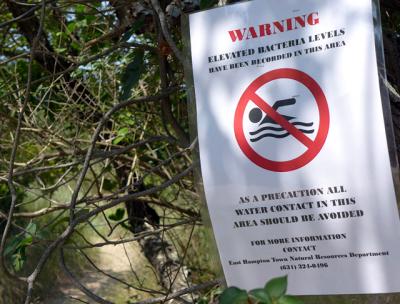Two-Day Swimming Ban at Havens Beach
Two-Day Swimming Ban at Havens Beach

A temporary no-swimming advisory was issued by Suffolk officials on Thursday for 64 beaches across the country. Of these, only one, at Havens Beach in Sag Harbor, was on the South Fork.
The advisory came after heavy rain swept the area on Wednesday. Based on past samples, the Suffolk Department of Health Services issues warnings based on the potential for bacterial contamination. Officials said that swimming and other contact with water at the affected sites should be avoided until at least two successive tide cycles had passed.
The current advisory will be lifted Friday morning. Up-to-the-minute listings of open and closed beaches can be obtained by phone at 631-852-5822 or the Department of Health Services beach monitoring web page.
Water Tests
In water samples taken by the Concerned Citizens of Montauk before Wednesday's rainfall, bacteria levels in many South Fork locations had declined from highs observed earlier in the season.
Kate Rossi-Snook, who manages the water testing for C.C.O.M., said that a full moon high tide might have helped keep bacteria levels relatively low.
Several traditionally problematic sites continued to show elevated "high" counts of enterococcus, including the shallow creek at Fresh Pond Park in Amagansett. Other sample sites with high readings were Pussy's Pond in Springs, and at the Nature Trail and the south end of Hook Pond in East Hampton Village.
East Hampton Town officials recently posted warnings at Fresh Pond about the possibility of bacterial contamination of swimmers there.







